

John Vifian interview
By Scott Stilphen
(2014)
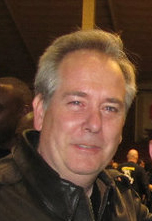
John Vifian got his start in game design working at Axlon for one of the best in the business, Nolan Bushnell. From there, he worked for at least a half-dozen major game studios such as Activision and Electronic Arts.
Q: What's your educational background?
John Vifian: I have a BSCS with an emphasis in hardware from San Francisco State University, 1987, and an Associates degree in Electronics Technology from the College of San Mateo, 1984
Q: What inspired you to pursue a career in game design?
John Vifian: Growing up I played a lot of card games and board games. When I got my first computer I programmed a battleship game. I really enjoyed coding my first games but never thought that I would able to make a living doing that..
Q: Was Axlon the first game company you worked for?
John Vifian: I was a fresh out of college no idea what I wanted to do. I answered a want ad in the newspaper. The as was for a coin-op programmer. I thought it had something to do with vending machines. It turned out to be a position to be a programmer working on a new arcade system.
Q: You mentioned working for Howard Delman at Axlon. I wasnít even aware he worked at Axlon!
John Vifian: Iím sure Howard can provide more detail. I interviewed with him. He of course was the man when it came to hardware design. I was hired to program a new generation of arcade machines. Shortly after starting the company started working on a few 2600 titles. I ended up working on mainly the 2600 for my time there.
Q: What were some of the games and projects you worked on at Axlon? I only know of one - The Adventures of Max. In the first issue of the Atarian magazine, Nolan Bushnell mentions playing a prototype of this game, and describes it as "a polar bear whose objective is to descend into a pit, steal a ruby, and get back out." In an interview with James Hague (from Halcyon Days), Axlon programmer Steve DeFrisco describes it as a game where "the player, Max, was to fall into deep holes and fight his way through caverns and caves back to the surface." and that the programmer left Axlon before the game was completed. Years later Steve later offered a different description in my interview with him: "This was one of the 'Designed by Nolan' games, which was never finished. It was to be set in Medieval times, the player is a knight with a sword. Thatís pretty much all we had. John moved on to another company and the game was never finished. The opening sequence of the character running and jumping into the hole, and falling to the bottom worked, but thatís it."
John Vifian: Yes, I worked on Adventures of Max. I designed the caves and caverns such that the player would hop from ledge to ledge, collecting gems and keys and fighting monsters along the way.
The design goal was to make a big game (deep caves) using little memory. I had the cave system, collectibles, and the lock and key system at an Alpha stage before I left. I think it had something like 1,024 screens in 4k byte of ROM.
Q: Steve DeFrisco mentioned there were only 4 VCS programmers at Axlon Ė himself, Pete Mokris, Tod Frye, and you. I only know of 7 Axlon games for the VCS: Steve worked on 3 games that were released (Secret Quest, MotoRodeo, and Klax), Tod worked on 2 that werenít (Save Mary and Shooting Arcade), and your Adventures of Max. The 7th game was a Breakout-type game called Off The Wall. Was this Peteís game?
John Vifian: Off the Wall was my game. Pete helped a lot with sound and design. This was my first game and I couldnít have done it without Pete and Steve's support and encouragement. We also had an artist (Scott __?) who did a lot with a few pixels.
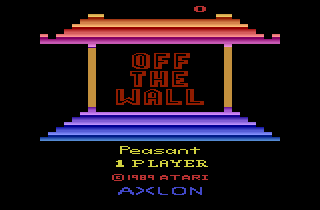
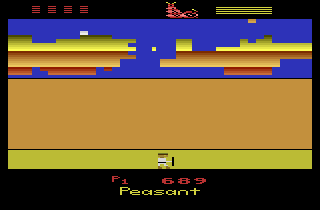
Q: What type of hardware systems were used to develop the Atari VCS games?
John Vifian: For development, we had a cartridge that plugged into a standard 2600, and a cable that was connected to an Atari 800.
Q: Do you recall any other interesting games or projects at Axlon that were never released?
John Vifian: The Vaculator! It was a motion ride for the arcade. It consisted of a seat on a platform with four airbags underneath the player, who would move the joystick and the seat would tilt and bank wildly. There was no game play. It was kind of like the next version of the rocket ship ride you would see outside of the supermarket. This was Peteís
creation. The whole thing was powered with a vacuum cleaner motor.
There was also a low-cost pop-a-shot basketball machine. The player would make as many baskets as possible in 30 seconds. It was basically a low-cost version of what you see in the arcades today. Steve did the programming and Pete did the mechanical. This was targeted for the home market.
Frenzy was a coin-op game that consisted of a matrix of 4x4 lighted buttons. Two buttons at random would light up and the player had to press the lighted buttons before time ran out. It was kind of like Milton Bradley's Simon and was meant for the arcade (Ed.: Simon was based on Atari's Touch Me arcade game). I wrote the ticket kicker, Pete built the hardware, and Steve wrote most of the
code. The whole thing ran on the same chip that was going into microwave ovens. It was not released in large numbers. I think there were less than 100 made.
Ping Pong Ball Cannon was another non-video arcade piece that never saw the light of day. It was a machine gun that fired ping pong balls. The prototype had a big chamber like a revolver. A vacuum pulled a ball into the chamber, a motor rotated the chamber, and compressed gas shot the ball out of the top chamber. This was all Peteís doing.
Q: Do you recall anything about the AC1 Simulator or Hat Trick II?
John Vifian: The AC1 was an extra wide version of the Bally Sente system. I think it was the core for Shrike Avenger. I don't remember anything about a Hat Trick II game, but if you talk to Pete, remind him that I am the world champion Hat Trick player :) (Ed.: I asked Roger Hector about the AC1: "I'm pretty sure Pete was the connection between AC1 and Sente's Shrike Avenger. Sente and Axlon had a casual sharing relationship for resources and tech because Nolan was involved with both.")
Q: Do you still have a copy of Adventures of Max by any chance, or any old paperwork or photos from back then?
John Vifian: I only have the original design doc for Off The Wall (the working title was "Zip'n Zap"), as well as a flyer for Frenzy

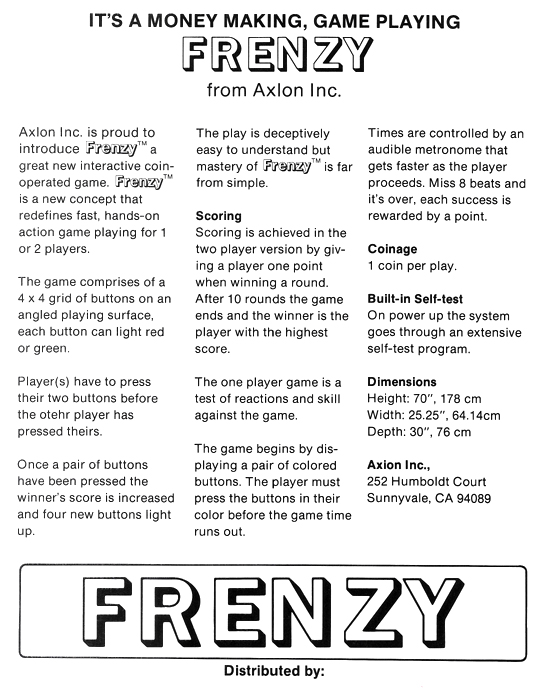
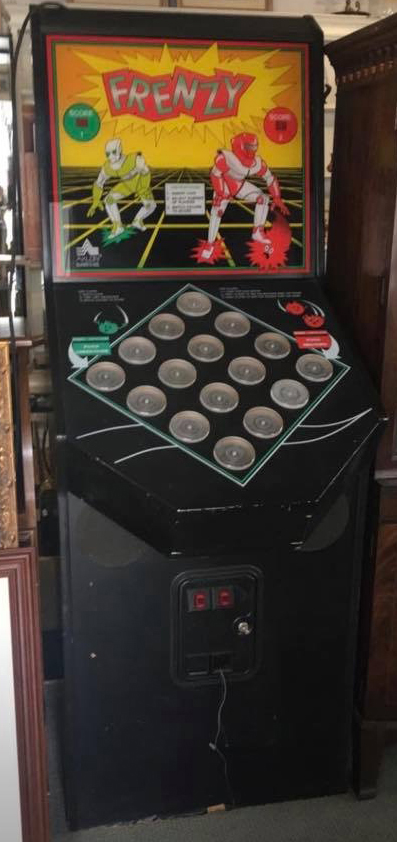
Photo of actual machine from Cassandra Chiles' website.
Q: Where did you go after Axlon?
John Vifian: After Axlon, I went to Activision and coded a few games before going to Lucas Arts, where I was fortunate enough to have an office on the ranch. I really enjoyed my time there. After Lucas Arts, I went to Spectrum Holobyte. Star Trek: The Next Generation: Future's Past for the SNES was the last game I did much coding on. After that, I moved into various production roles.
Q: What were some of your experiences working for Axlon? Any stories or anecdotes from those days that youíd like to share?
John Vifian: Axlon was a fun place. There
were always some new ideas floating around. Nolan designed a touch screen-based order entry system for a pizza parlor back in 1988. I still havenít seen anything better!
I started programming games very late in the 2600's life cycle and was lucky enough to work with Nolan, Howard, Steve, and Pete. I owe them all a debt of gratitude.
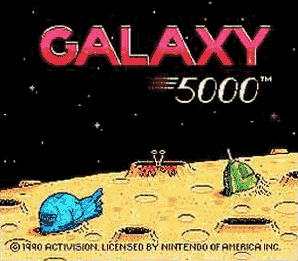 Q: Are there any Easter eggs in any of your other titles? Do you recall any fellow co-workers that did?
Q: Are there any Easter eggs in any of your other titles? Do you recall any fellow co-workers that did?
John Vifian: I worked with Dave Ross at Activision on Galaxy 5000 for the NES. We did a CRC check at the end of the game - if you played a "cracked' copy, you got a message that said something like, ďDr. Dave says Cheaters never prosper!Ē
Q: Do you still own any of your games for these systems, either as a keepsake, or to show friends or family?
John Vifian: I keep a copy of every game I worked on at my desk, but the only title I worked on at Axlon that shipped was Off the Wall,
Q: Did you ever attend any industry shows, such as CES or E3?
John Vifian: Yes, I go to at least a few shows every year.
Q: Which of your titles are your favorite, and what types of games in general?
John Vifian: Battlefield 2 - I was a development director for EA. It was a labor of love and in my opinion the best in the series. I made several good friends on the DICE team that I still stay in touch with.
Right now Iím playing a lot of base builder games such as Clash of Clans and the like.
Q: Have you stayed in touch with any of your former co-workers?
John Vifian: Yes, but there's too many to list ;-)
Q: What are your thoughts on how the industry has evolved?
John Vifian: In the early days, the hardware was very limited, and teams were small. The 2600 was an incredibly-limited platform. Itís pretty amazing the performance that people got out of it. Developers coded in assembly - there was no OS and very minimal libraries. There was minimal I/O. You coded very close to the metal and there wasnít much metal.
Modern Console/PC games push the envelope in so many different areaís. They receive input from a host of devices (motion sensing, touch pad, various controllers). They output to a wide variety of screens, from HD to 4K soon, and perhaps to Oculus. Internet connectivity is something that we take for granted today but it added another level of complexity to game design and development. Games are coded in high level languages using amazing game engines like Unreal and Unity.
Development times went from a few months to several years, and teams have grown from 1 or 2 to over 100. The cost of developing a AAA title now is into the tenís of millions.
Casual (mobile/web) is a space where itís easy to innovate and experiment. My son is making his first game, and taking it from white board to the storefront in an amazingly short amount of time. Even though the technical complexity of a mobile game is far greater than early console games, in many ways it feels much the same. Itís hard not to see mobile taking over the gaming market every year as mobile devices get faster and more powerful. Dedicated consoles
manufacturers (Sony, Microsoft, and Nintendo) are finding it harder and harder to find compelling features to justify yet another generation of consoles.
I think that games will continue to evolve and become more and more entertaining and engaging.
John was kind enough to provide us with a copy of the original Atari VCS Off the Wall design document. Enjoy!
| GAME | SYSTEM | COMPANY | STATUS |
| Off The Wall | Atari VCS/2600 | Atari (Axlon) | released |
| The Adventures of Max | Atari VCS/2600 | Atari (Axlon) | not completed |
| Frenzy | coin-op | Axlon | limited release |
| Galaxy 5000 | NES | Activision | released |
| Defenders of Dynatron City | NES | Lucasfilm Games | released |
| Star Trek: The Next Generation: Future's Past | SNES | Spectrum HoloByte | released |
| Top Gun: Fire At Will | PSX | Spectrum HoloByte | released |
| Star Trek Generations | PC | MicroProse | released |
| Star Trek: Birth of the Federation | PC | MicroProse | released |
| Road Rash 3-D | PSX | Electronic Arts | released |
| NCAA March Madness 98 | PSX | Electronic Arts | released |
| Battlefield 2 | PC | EA Games (Digital Illusions CE) | released |
| Battlefield 2: Special Forces | PC | Electronic Arts (Digital Illusions CE) | released |
| Battlefield 2: Modern Combat | PS2, XBOX | EA Games (Digital Illusions CE) | released |
| Madden NFL 99 | PC, N64, PSX | EA Sports (EA Tiburon) | released |
| NCAA Football 99 | PC, PSX | EA Sports | released |
| Madden NFL 99 | PC, N64, PSX | EA Sports (EA Tiburon) | released |
| Cyber Tiger | N64, PSX | Electronic Arts | released |
| Tiger Woods PGA Tour 2000 | PC, PSX | EA Sports | released |
| Buick PGA Tour Courses | PC, PSX | EA Sports | released |
| Tiger Woods PGA Tour 2001 | PC, PSX, PS2 | EA Sports | released |
| James Bond 007: Nightfire | PC | Electronic Arts | released |
| Brutal Legend | PS3, XBOX 360 | Electronic Arts (Double Fine) | released |
| Hellgate: London | PC | Electronic Arts (Flagship Studios) | released |
| Rock Band | PS2, PS3, XBOX 360 | Electronic Arts/MTV Games | released |
| Alice: Madness Returns | PC, PS3, XBOX 360 | Electronic Arts (Spicy Horse) | released |
| Shadows of the Damned | PC, PS3, XBOX 360 | Electronic Arts (Grasshopper Manufacture) | released |